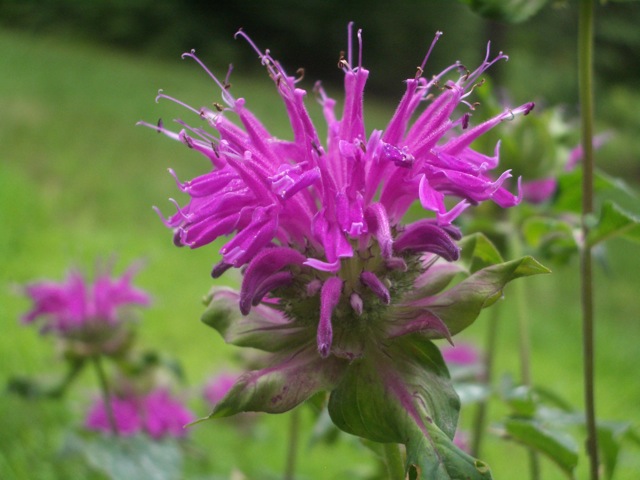By Maria Noël Groves, Clinical Herbalist, Wintergreen Botanicals, LLC
Did you know that many of those simple, mundane culinary and ornamental plants you have growing in your garden actually have alter egos with super healing powers? Rosemary goes great with chicken, but did you know that it may also help stave off Alzheimer’s disease? Or that sage can help with hot flashes? We’re about to talk about surprising ways that common culinary herbs and companion plants can also help your family stay healthy. But, first, I like to set a few safety rules…
The information in this article has not been approved by the FDA and does not in any way intend to diagnose or prescribe. Always consult with your health practitioner before taking any remedy. These plants are generally pretty darn safe – you’ve probably already consumed them in the form of food – but they can still have strong (generally positive, rarely not so positive) actions when consumed in large amounts or on a regular basis.
To be knowledgeable, safe, and connected with your medicine, I recommend that you…
1. Research an herb in at least three good sources before ingesting it (see www.wintergreenbotanicals.com for for recommended reading, articles, and informative links),
2. Listen to your body/intuition to determine if an herb resonates or doesn’t resonate with you.
3. Take proper steps to ensure that any wildcrafted or cultivated plant is what you think it is, AND
4. Check with your pharmacist for herb-drug interactions if you take prescriptions.
Ok, now to the fun stuff!
Culinary Herbs
The Alliums (Allium spp): Garlic and onions are the medicinal leaders of this family that also includes shallots, leeks, chives, etc. All of them have some level of antimicrobial action, making them perfect to suck on for sore throats and apply topically for fungal and bacterial infections. They are also heart tonics for blood pressure and cholesterol and may even help to improve blood sugar stability. It’s best to chop them up and let them sit for a few minutes to react with the air and become more powerful before adding them to recipes or eating them straight. It has to stink to work! Note: Raw garlic in particular can irritate the skin and mucus membranes, particularly in sensitive people.
Basil (Ocimum basilicum): This pesto hot shot, while not a medicinal knockout, is rich in antioxidants.
Cilantro (Coriandrum sativus): The fresh foliage of cilantro is rich in chlorophyll and is reported to help detoxify heavy metals by binding to them and eliminating them from the body, particularly when they’re consumed at the same time (say, cilantro-stuffed bass). The tan seeds are traditionally used to improve digestion and ease gas.
Dill (Anethum graveolens): Among our best herbs for digestive upset, the “weed” and particularly the seeds act as an antispasmodic to alleviate stomach pains, settle nausea, and relieve gas and colic. No wonder pregnant women love pickles!
Fennel (Foeniculum vulgare): Our other digestive extraordinaire, fennel also acts as an antispasmodic, helps quell nausea, and relieves gas and colic. The bulb and fronds make a lovely after dinner cordial. Seeds can be chewed. All parts can be used for tea.
Horseradish (Armoracia rusticana): Freshly grated horseradish root helps to thin mucus and increase circulation, making it one of the best for symptomatic relief of nasal congestion and sinus colds.
Lovage (Levisticum officinalis): This surprising plant is a master of disguise within the parsley family. The above ground greens can be used similarly to parsley (see below). The fall-harvested root is used as a local/sustainable alternative for two prized and very different medicinal plants: osha and dong quai. Mimicking osha, lovage root helps to increase circulation, warm and clear lung congestion in colds. Mimicking dong quai, it may be used as a blood builder and reproductive tonic.
Oregano (Oreganum vulgare): Pungent oregano—NOT marjoram—is fantastic as an antibacterial and antimicrobial for stubborn colds and infection. The essential oil is the strongest, but home-made alcohol extracts and teas are also helpful. It has to really smell like oregano and have that bite to work.
Parsley (Petroselinum crispum): Parsley greens are among our best herbs for detoxification. Eaten in abundance or juiced, it appears to help remove toxins and acts as an anti-inflammatory. As food, juice, tea, or other extract, it is a fantastic diuretic for water retention and may also be helpful for lowering blood pressure. Seeds are strongest diuretic, but leaves are safest.
Rosemary (Rosemarinus officinalis): Rosemary is a great circulatory tonic and anti-inflammatory. The old saying “Rosemary for remembrance” might mean more than a lasting fragrance. If taken daily, the herb may help improve memory and help to stave off Alzheimer’s. The tea can also be used as a hair wash for dark hair and the essential oil—diluted and massaged into the scalp—may help stimulate hair growth.
Sage (Salvia officinalis): Astringent and antiseptic, home-made tea or extracts can be used as a gargle for sore throats. It is reported to help lessen excessive perspiration, hot flashes and night sweats, and to stop or slow milk flow in lactating moms. Its California relative white sage is among the best antibacterial herbs. Plain old garden sage is a weaker but local alternative.
Thyme (Thymus vulgare, T. spp): Yet another Italian herb that’s useful for colds. Thyme has a particular affinity for the lungs, making it useful for sore throat, chest congestion, and even mild asthma (with a practitioner’s supervision). Fresh herb tincture is strongest, but it also makes a great tea. In a 16 oz thermos cover a handful of fresh thyme sprigs, 3 lemon wedges, and 1 tablespoon of honey with boiling water, cover and let sit 1-2 hours before drinking.
Tea Herbs
Anise Hyssop & Korean Licorice Mint (Agastache foeniculum, A. rugosa): The delicious licorice-tasting leaves of this mint family plant can be used as a weaker alternative to fennel (above) and also helps to sweeten tea without sugar.
Catnip (Nepeta cataria): Minty and slightly bitter, common catnip goes beyond feline entertainment. As a tea or tincture, it can stimulate sluggish digestion and get the juices going. It’s also a mild nervous system relaxer so it’s used for a nervous stomach and to help children sleep. As a diaphoretic, a warm cup of tea can help break a fever. It’s often used for children, but is appropriate for adults as well.
Chamomile (Matricaria recutita): Used similarly to catnip, chamomile is drunk for relaxation and to help improve digestion. Recent research suggests that drinking the tea regularly may help prevent H. pylori—a causative bacteria in ulcers. Often used for babies and children for colic, teething, irritability, and insomnia. Some folks may experience hayfever-like allergies to it.
Lemon Balm (Melissa officinalis): Though slightly bitter, this fantastic tea herb blends well with mints and other lemony herbs. Lemon balm also helps improve digestion, settle the stomach, and is used for relaxation. Its essential oils also act as a mild anti-depressant and the herb has been researched for its anti-anxiety affects, making it great night or day. Topically, it binds to receptor sites to prevent the herpes virus (cold sores, chicken pox, shingles, genital herpes) from replicating and spreading.
Mint (Mentha spp): Peppermint (M. piperita) is the medicinal mint for improving digestion and quelling nausea, and its aroma is reputed to lift the spirit and increase productivity. All the mints add a delightful flavor to tea. Add a sprig to your water bottle in summer for a light, cooling beverage.
Companion Plants & Ornamentals
Bee Balm (Monarda fistulosa & M. didyma): Prized for their lovely color and beautiful pollinators, bee balms are also great medicine. The spicy flowers and foliage can be made into tea for sore throats, chest congestion, and colds (it’s a little acrid on its own but gets better with honey and/or mint). It also makes a great herbal honey, tincture, or steam. The best varieties taste a lot like thyme or oregano. Less acrid and beautiful flowers are great in salads or sprinkled on a sandwich.
Calendula (Calendula officinalis): Also called pot marigold because the orange and yellow flowers can be simmered to make a nutritious, carotenoid-rich broth. Calendula provides lutein to nutritive teas but is especially prized as an herbal oil. Topically it helps with itches, rashes, allergies, and many other irritating skin conditions. Also great for baby’s skin and diaper rash.
Comfrey (Symphytum officinale): The leaves and root of this compost extraordinaire are prized among herbalist for their allantoin, a cell proliferative for internal and topical wounds, and for their soothing mucilage. Great to help soothe bronchitis and deep lung infections (healing/soothing, not so much fighting the infection itself), as well as for gastritis, heartburn and ulcers. Topically for surface wounds—it can dangerously close the skin too quickly for deep wounds. Also great for rashes, burns, etc, topically. Mashed fresh leaf poultice is best, but herbal oil may work, too. Internal use is controversial (illegal to sell for internal use in US) because the plant contains pyrrolizidine alkaloids that eventually build up and become toxic to the liver, particularly in extremely large or long-term doses. Many herbalists still use it short term (1 week) for adults. Do your own research; it’s your call.
Roses (Rosa spp): Rose petals area gentle astringent topically for skin irritations and in bodycare for aging skin. Internally as tea for boggy tissue in the gut as well as diarrhea and sometimes bleeding. Also delicious in a beverage tea. Rosehips are rich in vitamin C.
About Maria:
Maria has been working with herbs for more than 15 years and been formally educated by some of the country’s top herbalists, including Rosemary Gladstar and Michael Moore. She’s certified as a clinical herbalist through the Southwest School of Botanical Medicine and currently runs Wintergreen Botanicals, an herbal clinic and education center nestled in the pine forest of Bear Brook State Park. Maria’s focuses on educating and empowering people with plant medicine: she sees clients, writes for various national and local publications, and teaches extensively throughout New Hampshire. Her website www.wintergreenbotanicals.com is loaded with information, offering people a window into the world of herbalism.






Interesting info… Thank you…
Glad you found it useful Michelle!
I have some of these growing in my yard. Maybe I should try the thyme tea – I’d like to see if I could get my daughter to drink it.
I love the idea of bee balm tea – never thought of drinking it, but I bet it would be great. Let me know if you try the thyme!